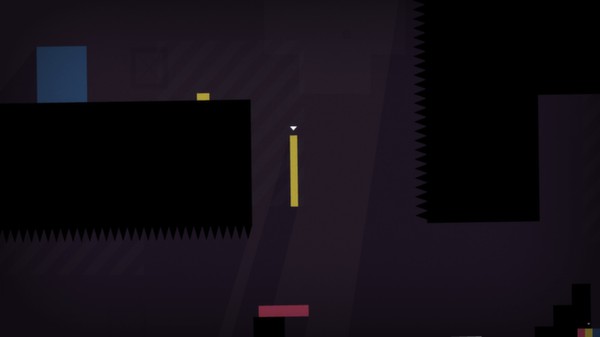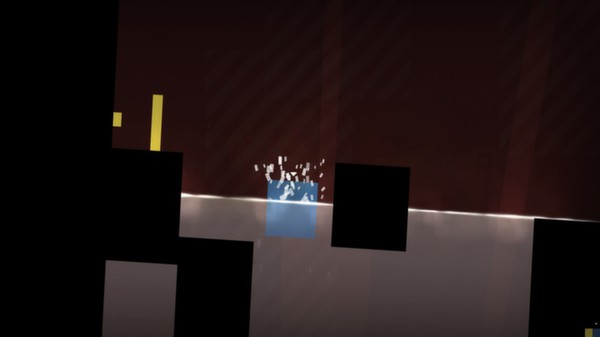I would be friends with Thomas. Seems like a nice fellow, even if it's not… you know, a fellow.
Thomas Was Alone is weird. At its core, it's a game about rectangles with unique abilities that need to be utilized to advance through puzzles. While it might sound entirely basic—and it is—it's also a game that's made me give a flying quadrilateral about these blocks, which I didn't know was possible, even though I've been playing video games since my nubs could hold a controller. And it's all because some writer decided to do some amazing characterization and name the blocks I need to maneuver around to reach the designated space.
Thomas is a block. I know there are probably clear screenshots here to draw from, but I don't have them as I'm writing this, which is actually a good metaphor for how this game should be described. Thomas meets other blocks that help him reach new heights, press buttons, open up environments, get around obstacles, and escape to the next space. As he meets friends like Chris and Claire and Laura, he has harder and harder puzzles to solve and more friendships to make… which make him less lonely. Because—and this is the key—Thomas is a sentient AI. At first he just wants friends, but after he makes a few, he figures out his purpose in "life".
Except that he's a block. Like I said, it's weird.
While at first glance, it looks like a game that could run on an Atari VCS/2600, the design of the stages is sparse and specific, with some dynamic shadows and a combination of the bleak and colorful. Thomas and his growing group of friends pop against the backdrop with their unique colors and sizes, so they're never really hard to find when things seem complicated. Even the sound effects are basic, simple, classic-sounding thuds and thumps giving weight during and after jumps which sent me back to earlier platforming days with Mario and company. As a whole package, think of the game as a combination of basic gameplay from Super Mario Brothers, the gorgeously simplistic-in-appearance Everyday Shooter, and the feel of an artistic puzzler like Portal.
The puzzles all wrap around a simple concept: start here and end there. Since all of the characters are of unique sizes and shapes, each with a unique ability, they all need to function together to reach their specific ending point. Early on, when figuring out the different abilities of each one, it's the little hazards that come to mind… one that caught me often was falling into the water with a few blocks on my back, and watching them drown after they bounced off my back. After a few stumbles, it's easy to see how everything fits together like a Tetris puzzle, and rewarding to see just what the development team came up with to solve. I haven't called out "this is beautiful and brilliant" so often in a long time. Playing with gravity is fun, kids!
Where this really shines is the storytelling., I define art as something that can be experienced that can elicit an emotional response from the person experiencing it. A good poem can move someone—that's art. A painting can show a scene that can remind you of a simpler time—that's art. A game that can make me care, actually drive me on through characters alone that don't even have faces—that's an amazing piece of art. It's one thing to tell a story, anyone and any company can do that. But to tell a story well? That takes an exceptional person, or an exceptional team, and in this case a great narrator (the always-great Danny Wallace).

This game takes me back to when I only played games to see the next area, to drive emotionally forward to a place I hadn't been before, like Super Mario Brothers 3 did to kick me into this hobby in the first place in 1990. I've had trouble through the years really relating to characters in games, with the occasional Chell and Neku Sakuraba along the way to help me relate, but Thomas surprised me… with only a narrator to provide his insights and emotional state.
To be perfectly honest, I couldn't find any serious faults with the game. Sure, it's short, but it's short in the way Portal was: It utilized its length and space well, even if it can be completed in a few hours. It's simplistic in appearance but fascinating in the quality and originality of puzzles, and there are some great touches, like the way a block might ripple after a jump or shadows moving smoothly in the background for each moving piece. It would be nice if there were more options and little modes, like the ability to create puzzles for Thomas and his companions to maneuver through. But for the smiles this brought me as it stands, I can't help but feel thankful I was able to play it.
The key word in the Thomas Was Alone for me is "was." I really hope more people find and download this gem, because it's totally worth the effort. In many ways it's a lot like a good book, where when you're done, you feel slightly alone having experienced it. I wish I could be critical, I wish I could be funny, I wish I could be… something. Reviews for good games are harder to write than reviews for bad ones. I thoroughly enjoyed this game. And this is why we should be supporting indie developers more.
-
Story got me caring about, essentially, pixels
-
Minimal aesthetic is detailed like crazy
-
Music is dreamy and lovely
-
Controls are tight and easy
-
Puzzles are interesting, though too easy to figure out
-
Short but fulfilling







